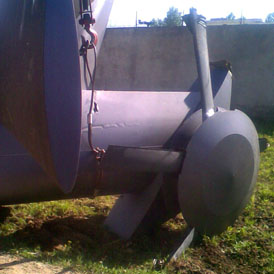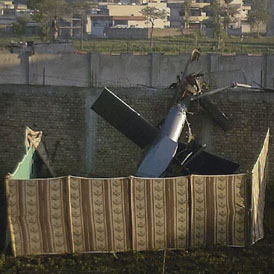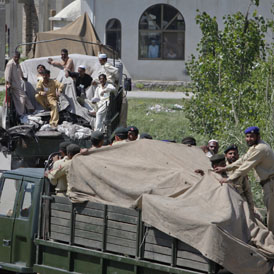‘Stealth chopper’ helped hit bin Laden
A previously unseen “stealth helicopter” was used in the raid that led to the death of Osama bin Laden, aviation experts tell Channel 4 News.

A new design of “stealth helicopter” was unwittingly revealed to the world for the first time during the raid that killed Osama bin Laden, according to aviation experts.
US special forces soldiers launched their attack on the al-Qaeda leader‘s Pakistan hideout after flying there in what US government officials initially said were a pair of Sikorsky UH-60 Blackhawk helicopters.
The commandos destroyed one of the aircraft after it made a “hard landing”, but images emerged of design details that differ significantly from the standard Blackhawk, prompting a storm of speculation among military analysts that a new piece of classified hardware had been seen in action for the first time.
A pan-like cover can be seen over the aircraft’s rear rotor blade – a modification experts say would reduce noise and the helicopter’s radar profile.
According to Bill Sweetman of Aviation Week, photographs of the chopper’s heavily-damaged tailpiece show evidence of a “silver loaded finish”. This is designed to make it harder for infrared sensors to detect the helicopter’s presence – reducing the risk of being shot down by anti-aircraft missile.
The shape of its tailboom has also reportedly been altered significantly to reduce the chance of it showing up on radar screens, while the tail rotor features an extra blade – something that would enable it to fly more quietly, according to Tony Skinner, editor of Defence Helicopter magazine.
“Even if it was simply a special forces modification to a Blackhawk we hadn’t heard anything about it until now.” Tony Skinner
Mr Sweetman speculates that, had soldiers from Seal Team Six not blown up most of the helicopter, it would have featured extra blades on the main rotor and other features intended to cut down noise.
Experts say military helicopters are still relatively noisy and have a significant radar signature compared to slimmer stealth planes and drones, but the modifications would have bought the strike team valuable extra time before being detected by the Pakistani authorities or Bin Laden’s guards.

Mr Skinner said the existence of the aircraft had “taken most of the commentators and experts by surprise”, adding: “Even if it was simply a special forces modification to a Blackhawk we hadn’t heard anything about it until now.”
He said the American military’s interest in stealth helicopters had appeared to wane after plans to develop the radical Comanche model were scrapped in 2004.
The US military later conceded that the downed chopper was “a new version” of the Blackhawk but did not reveal any more detail.
Senate Intelligence Committee chairwoman Dianne Feinstein denied the packed helicopter had crashed or been shot down, saying: “The temperature was 17 degrees higher than anticipated, and based on the temperature, and the load in the helicopter, the helicopter began to descend, and so it was a kind of controlled but hard landing.”
Other officials said the landing was hard enough to disable the helicopter, which the US team destroyed. The second Blackhawk then landed and evacuated US troops along two Chinook helicopters which had flown in as back-up.
US sources said pilots used radar “blind spots” in the hilly countryside along the Afghan border to enter Pakistani airspace undetected in the early hours of Monday.
Eyewitnesses who saw the operation unfold in Abbottabad reported that the helicopters had been flying “very low” as they approached bin Laden’s compound.
Mr Sweetman said the fundamental difficulty of reducing a helicopter’s radar profile meant the pilots who flew Seal Team Six to their destination – reported to be members of the 160th Special Operations Aviation Regiment – still rely on traditional skills of hugging the terrain to avoid detection.

He told Channel 4 News: “They can get down pretty low, and the 160th are famous for doing that.
“It’s their normal method of operating and they would have been doing that for weeks beforehand in Afghanistan. They would have had the flight time planned down to seconds. They’re pretty famous for it.”
Pakistani soldiers were seen removing the wreckage of the helicopter from the compound in covered trucks after the attack.
-
Latest news
-
‘I violated my moral compass working for Trump,’ former lawyer testifies3m

-
Working class creatives in film and TV at lowest level in decade5m

-
Israeli police investigating attack on Gaza aid convoy4m

-
Biden announces major tariff increase on Chinese-imported green tech3m

-
‘If NHS can afford it, people with obesity should have Semaglutide,’ says weight loss expert5m

-




